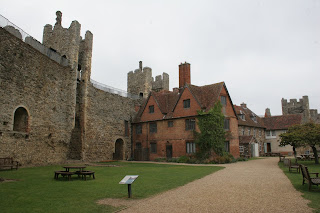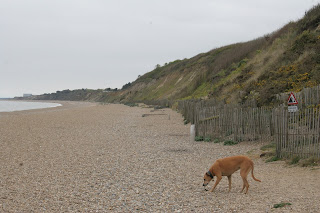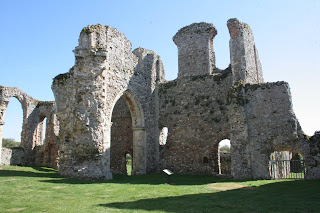 |
| Lottie outside Framlingham Castle |
 |
| Remains of the 13th tower |
“The last major visit
on my list is Framlingham.” Van-Man said over breakfast. Before we set off he
did two Motor Home tasks filling with fresh water and emptying the grey water.
After that we headed for Framlingham Castle which we found easily. We managed to
park in a longer space in the small car park.
 |
| thick castle walls with decorative chimneys |
 |
| Inside the castle walls |
 |
| Lottie by the poorhouse |
Before entering the
castle we walked Lottie off her lead around the outside of the castle. The whole
of the outer wall is still standing, along with 12 of the 13 towers. It was an impressive
sight with strange chimneys up on the battlements.
Some of the
outbuildings are missing but we entered the castle with great curiosity. All of
the original interior buildings had gone but the walkway round the top of the wall
was complete and begging to be explored.
 |
| chimneys on the fortified wall |
 |
| looking down from the castle walls |
 |
| one of the 3 chimneys connected to a fireplace |
 |
| vast interior |
The
building occupying the position of the great hall was part of the poor house
which the castle owner had built as he felt they needed supporting. Now it is
the English Heritage shop and cafe. Compared to other poor houses the residents
were well treated and not overworked. One resident entered the poorhouse pregnant
had her child there and remained for the rest of her life. The baby daughter
however left the poor house, married and had five children. Lottie took us
round the ramparts with enthusiasm and then took us round the rest of the castle
at a speedy pace. At one place we could see how a building built before the
walls were thickened and reinforced had been incorporated into the outer wall. The
curious chimneys had been added by the owner to persuade King John that it was
a private residence not a fortification. That must have been tricky to pull off
when the walls are two metres thick in places and
only three chimneys were connected with a fire place.
Lottie allowed us to drink hot
beverages while she lat patiently then demanded to move on.
After
a last look around we headed to Sally for our lunch. While eating several cars
came in and tried to park without success as the car park was full. One car
parked on the end of the middle row then had to move as a Beemer couldn’t get
past.
Having
eaten we surrendered our parking slot and drove to Dunwich which boasted of heath
land beach and marshes.
“What
is that?” I asked on the way out of Framlingham. A tall man was pedalling a Penny
Farthing along the road, towering above an old fashioned bone shaker.
“I
don’t know how they ride those,” I said.
“I
don’t know who though them up,” Van-Man replied. “It’s a crazy design.”
On
the road to Dunwich Van-Man stopped at a big car park at Westleton Heath.
“Let’s
walk Lottie here in case Dunwich is a bust,” Van-Man said. The whole area was a
mix of trees and heath with gorse in flower on sandy soil.
 |
| marshland flowers |
 |
| Lottie on the salt marsh |
As
we walked we found ourselves warhwed by big signs stating DANGER ARCHERY AREA. While
we skirted the huge area I felt I was about to be attacked by Robin Hood and
his Merry men, but they didn’t materialise. I guess they were still in Nottingham.
Once clear of the archery we passed Exmoor ponies grazing also a long way from home.
A sign proclaimed they helped keep the balance of trees to grassland. An electric
fence prevented them straying over to the archery shooting range.
 |
| Sally in the car park |
After
a 40 minute walk we resumed the drive to Dunwich. The road narrowed as it
approached the village but it was just wide enough for Sally. We followed the
signs to the car park which turned out to be huge, free and right behind the
sea defences. It was on the same level as the marshes and was possibly below
sea level.
 |
| looking towards Sizewell |
Having
parked we stepped out to look around our Lurcher leading the way as if we hadn’t
walked her. There must have been good sniffing there.
The
beach was shingle and the sea defence a massive shingle dyke so we walked between
the dike and the marsh. Of course Lottie had a dip in one of the marshy pools
but emerged mud free. When we climbed the dyke to look at the sea with our
reluctant hound trailing behind we found a slim sand path between the piles of shingle.
Lottie
perked up and consented to walk along the sand.
When
we turned around we could see Sizewell power station in the distance. However the
area was picturesque and peaceful. Lottie charged around once we crossed the
shingle and reached the marshy area
When
we found an information board back at the car park it told us the original
village had been swallowed up by the sea in the 11th century leaving
the small part we have today. We spent over an hour there drinking in the
scenery.
 |
| I still miss our boat |
We
returned to the campsite after 4.00 but Lottie waited patiently on the grass while
Van-Man hooked up the electricity and I put the seating down. We always travel
with it up or a loopy Lurcher would jump up on the sofas and scrabble at them
while we were driving along. After eating every scrap of her dinner Lottie came
into the Motor home and slept. That was one exhausted Lurcher.









































